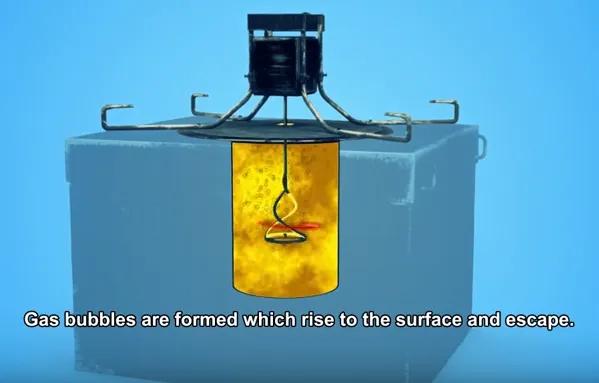Published - 27th Sep 2024

To watch our animation on how degassing forms an important part of the metal pouring process please click here.
Removing gas helps to optimise casting quality and performance
Degassing is the process used to remove gases from molten metal before it solidifies. Degassing in sand casting can significantly enhance both the appearance and performance of the finished component. At Haworth Castings, we supply sand castings to performance-critical industries, so our customers depend on us to optimise our manufacturing process to achieve the best castings.
In this blog, we explain the challenges of gas for molten metal; how we remove it; and the benefits of degassing in sand casting for high-quality components.
Aluminium and its alloys are widely used in casting because they produce components that are lightweight but strong, can operate at extreme temperatures and have excellent corrosion resistance.
However, aluminium is also highly reactive and will react with gases, most commonly the hydrogen freely available from water in the atmosphere. Hydrogen gas dissolves in molten aluminium, but as the metal cools and solidifies the hydrogen reverts to a gas. This trapped gas can create defects such as voids and porosity which can affect the mechanical and aesthetic qualities of the casting.
At Haworth Castings, we design bespoke running systems for each customer project. By optimising the flow of molten metal into the casting, we can prevent gas from becoming physically trapped.
To degas the molten metal, we purge it using an inert gas. A rotary impeller degasser (RID) is used to introduce nitrogen into the molten metal before the pour. The rotating impeller creates small bubbles of nitrogen that react with any gas in the molten metal, creating a compound that floats to the surface and can be removed.
Degassing plays a crucial role in sand casting by improving the flow characteristics of molten metal, reducing defects, and enhancing the overall quality of the castings.
Degassing through careful running system design facilitates smoother and more controlled filling of the mould. When the metal is free of gas bubbles, it can flow more easily into intricate cavities, ensuring that every part of the complex geometry is filled uniformly. This reduces the risk of defects caused by turbulent flow, such as air entrapment and incomplete filling
By effectively removing dissolved hydrogen through degassing, the incidence of porosity is minimised, delivering castings that are stronger and more dense. This is particularly important for complex geometries where intricate details and thin sections are present. Gas porosity can lead to weak spots and structural failures in these areas, so its reduction is essential for maintaining the integrity of complex shapes.
Degassing helps refine the microstructure of the casting by reducing the presence of inclusions and oxides. A finer microstructure leads to improved mechanical properties and better performance of the final product, including enhanced strength and fatigue resistance. This is particularly importance in casting complex shapes where uniformity is essential.
Degassing contributes to a smoother surface finish on castings. By reducing the number of gas-related defects, the surface quality of the final product is improved. This is particularly important for components that require precise tolerances or aesthetic attributes.
Degassing promotes consistency in casting quality, helping to ensure that each batch of castings meets the required specifications and performance standards. Such reliability is crucial for applications in industries such as automotive and aerospace, where safety and performance are paramount.
By minimising defects associated with gas entrapment, degassing reduces the likelihood of defects which might lead to wastage. This efficiency is particularly beneficial in the production of complex geometries, where the costs associated with defects can be significant. A more reliable casting process leads to higher yields and lower production costs.
Degassing is most commonly linked to aluminium casting but can improve the casting process for other metals such as copper-base alloys. The degassing process may be different, but the aims are the same.
We advise our customers on the best degassing method to achieve optimal results for the specific alloy and component being cast.
Degassing in sand casting is key for complex and high-quality components. Removing trapped or dissolved gas from the molten metal helps to optimise casting quality and performance, so that we can deliver precision aluminium sand castings for the defence, aviation, marine, medical, energy, automotive and safety-critical industries.
What is degassing in sand casting?
Degassing in sand casting is the process of removing dissolved gases from molten metal to prevent defects such as porosity and voids in the final casting.
Why is degassing important in sand casting?
Degassing is crucial as it improves the quality, strength and surface finish of the casting by eliminating gas-related defects.
What methods are used for degassing in sand casting?
Common methods include purging with inert gases like nitrogen using a rotary impeller degasser.
How does degassing improve the mechanical properties of castings?
Degassing refines the microstructure by reducing inclusions and oxides, leading to enhanced strength, fatigue resistance and overall performance of the casting.
Can degassing be applied to metals other than aluminium?
Yes, degassing techniques can be adapted for other metals, such as copper-base alloys, to improve casting quality and performance.
What industries benefit from degassing in sand casting?
Industries such as automotive, aerospace, defence, marine, medical, and energy benefit from degassing as it ensures the reliability and performance of critical components.
If you have a project, talk to our experienced sales team
Contact us